#Thrasher Presents: Skate and Destroy
Explore tagged Tumblr posts
Text

17 notes
·
View notes
Text
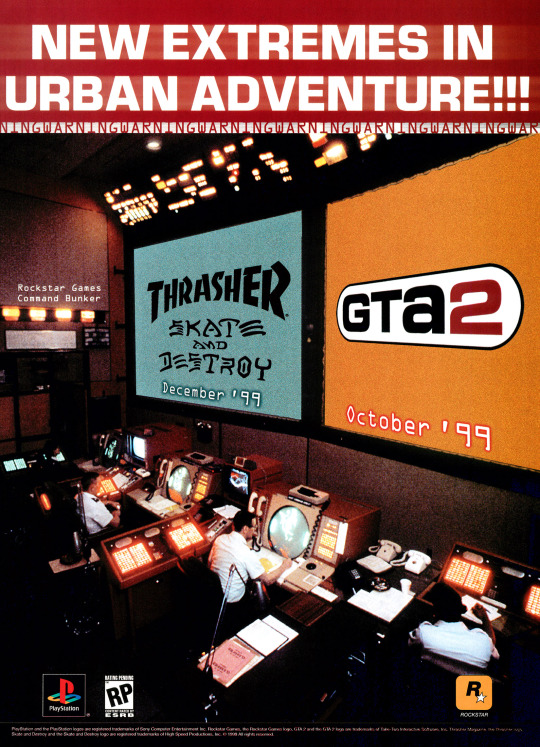
Thrasher Presents Skate and Destroy/Grand Theft Auto 2
"New Extremes in Urban Adventure!!!" (Gamers' Republic #15, Aug. 1999)
83 notes
·
View notes
Text
HISTORY OF SKATEBOARDING
Introduction
Skateboarding is something beyond cruising around. Skateboarding is a way of life. Skateboarding is love. In the course of recent years Skateboarding experienced a sort of advancement.
The central matters of the story we cleared up for you in our skateboarding history:
By the mid 1950s, surfing can be followed as the wellspring of skateboarding. A few surfers had the plan to exchange the sentiment of riding waves onto the lanes to resist times of days with a delicate swell. Not with no reason these fellows were classified "black-top surfers". At two spots on the planet a sort of a skateboard was created at the first run through in the mid 1950s: California and Hawaii. They utilized shorter surfboards and wheels made out of metal without certain direction. In the late 1950s, skateboarding had a first pinnacle. Amid the post-war period, the U.S. economy blasted and this likewise influenced the toy business. Amid that time, the toy business ended up mindful of the load up with wheels. In 1959, Roller Derby discharged the principal official skateboard with some new specialized improvements. In this manner, the taking care of qualities have been improved. Consequently, skateboarders had the capacity to grow new traps and moves.
bite the dust ersten Boards
THE 1960S
Between the years 1959 and 1965, skateboarding turned out to be increasingly more mainstream in the United States. Especially influenced were the states on the east and west drifts. Because of the mechanical improvement, the skateboard's status changed from toy to sports hardware. In 1962, the surf shop "Val-Surf" in Hollywood sold the main self-delivered skateboards. These sheets highlighted a run of the mill surfboard shape and roller skate trucks and were sold as total sheets. Around the same time, the organization Patterson Forbes built up the first mechanically created total loads up with progressively created trucks. In 1963, the distributer of the "Surf Guide Magazine" Larry Stevenson discharged the main commercial for skateboards in his magazine. Likewise the attire business concentrated increasingly more on skateboarding. A standout amongst the most acclaimed skateboarding shoe brand named Vans was built up in 1966. From this day on, Vans bolstered skateboarders from everywhere throughout the world. Particularly shoe organizations like Vans, Etnies, Converse and DC Shoes created and fabricated skateboarding related footwear and streetwear.
Vans Old School
Another milestone occasion in 1963 was the primary skate challenge in Hermosa Beach, California. Skateboarding was not simply cruising any longer. Skateboarders demonstrated their aptitudes in various controls like slalom or free-form and organizations began to amass a group to support the riders. As the fame of skateboarding started to extend, the principal skateboarding magazine "The Quarterly Skateboarder" was distributed in 1964.
A next huge advance was the further improvement of the state of the sheets. Larry Stevenson concocted the "kicktail", and with it came significantly more conceivable outcomes to ride a skateboard.
Old fashioned Boards
THE 1970S
The main reliable thing is change thus it went to a point where everything changed for skateboarding. Honest Nasworthy's innovation of urethane wheels in 1972 made it feasible for skateboarding to return. Nasworthy began the organization Cadillac Wheels and with the new material it was conceivable to ride smoother, quicker and progressively agreeable. An assortment of controls, for example, free-form, downhill and slalom encountered a genuine high point. New magazines like the "Skateboarder Magazine" from 1975 were distributed and new occasions were propelled. In 1976, the principal falsely made skate park was introduced and new stops developed with new components, for example, vertical slopes and kickers.
Gadillac Wheels
In the mid-1970s, skateboarding achieved Germany. The American officers carried the pattern with them and by 1976 Munich turned into the principal German skateboard focus. In Munich Neuperlach, the principal skate park was manufactured, first skateboard magazines pursued and in 1978 the primary German skateboard titles were held in Munich.
All the distinctive riders with their individual styles upgraded bunches of new traps. In this way, skateboarding equipment was grown further and further: Shapes changed, sheets ended up more extensive, got progressively sunken and they highlighted nose and tail.
At that point in 1978, Alan Gelfand imagined a move that gave skateboarding another progressive bounce: The "Ollie", which considers the best trap at any point concocted and totally upset skateboarding. That was the introduction of road skateboarding!
Alen Gelfand - Ollie
THE 1980S
Rodney Mullen was one of the main riders who exchanged the Ollie for various moves onto the boulevards and spread another style of skateboarding. Alongside other fun game exercises like BMX or inline skating, road skateboarding grew to an ever increasing extent and turned out to be prominent.
Rodney Mullen
In 1981, the "Thrasher Magazine" was established and from that point forward, this magazine represents road skateboarding, the center scene, punk shake and the way of life motto "Skate And Destroy". In 1983, another notable magazine was established, specifically the "Transworld Skateboarding Magazine". Beside these magazines, a couple of littler ones were established and more skate shops opened. Along these lines, the fame of skateboarding kept on developing. A worldwide scattering of new traps and concealed skate moves permitted the primary skate recordings on VHS. Videography has turned out to be progressively critical to the scene.
Thrasher
Titus Dittmann was instrumental in the advancement of skateboarding in Germany. He imported skate-related items from the US and composed challenges and different skateboarding occasions. The "Münster Monster Mastership" wound up one of the greatest universal skateboarding rivalries during the 1980s. Hence, skateboarding turned out to be increasingly more well known in Germany.
From the mid-1980s on, it was conceivable to procure great cash as an expert skateboarder and the skateboard business blasted in the US. In the late 1980s, organizations like Powell Peralta, Santa Cruz and Vision commanded the universal market of the scene. The design was for the most part controlled by shoes. Shoes by Vans, Converse or Vision progressed toward becoming leaders for the skateboarding scene.
Powell Peralta
Skateboarding was presently completely settled the US and in Germany and vert skateboarding was supplanted by road skateboarding. The quantity of skateboarders expanded altogether and expert skateboarders turned out to be increasingly more celebrated simply like baseball or football stars.
FROM THE 1990S
In the mid 1990s, skateboarding experienced a further profundity stage because of the expansion in different pattern sports. So skateboarding returned to its foundations. But since of the digitalization, skateboarding kept up its essence out in the open. From the mid-1990s, the advanced skateboarding encountered a next high stage, which proceeds until today. Super occasions like the "X-Games" were propelled and broadcast. Because of various magazines, every one of the occasions, recordings and to wrap things up the web, skateboarding ended up basic around the world.
Due to brands like Chocolate, Girl Skateboards or Flip Skateboards, the skateboarding equipment was grown to an ever increasing extent and skateboarders could purchase amazing skateboards in each greater city.
Reynolds and Koston
More markers are the huge and worldwide known occasions of "Road League". "Road League Skateboarding" is a challenge arrangement for universal star skaters. Here, you just observe the best road skateboarder you can consider like Nyjah Huston, Eric Koston, Paul Rodriguez, Andrew Reynolds, Ryan Sheckler or Torey Pudwill. Because of the money prizes of 200.000 US Dollars or more for the victor and 10.000 guests at the "Road League" quits, skateboarding has turned into a pro game.
Road League
In Germany, road skating is the most prevalent control at challenges simply like in the USA. The European and German skate scene is free, has its own industry, geniuses and a national challenge arrangement. This is a proof of how enormous the job of skateboarding is in our general public.
Skateboarding has turned into an occupation for many individuals. Due to the expanding organizing inside the skate scene, skateboarding will develop and acquire more advancements what's to come. Yet, for the greater part of us, skateboarding is and will be a diversion and a demeanor to life.
2 notes
·
View notes
Text

So...there are actually quite a few playable women that have been featured in Rockstar Games, including within the Grand Theft Auto Series.
Here is a full list of the ones on their games page right now:
Grand Theft Auto not available on PS1 or Japanese version
Divine
Katie
Ulrika
Mikki
Thrasher: Skate and Destroy:
5. Jasmine
Grand Theft Auto II (GBC port):
6. Candy
7. Gretchen
Oni:
8. Konoko
State of Emergency:
9. Anna Price
Grand Theft Auto: Liberty City Stories Multiplayer
10. Maria Latore
11. Toshiko Kasen
12. Lucy Lastic
13. Ophelia Lardaz
14. Mrs. Menalot
15. Anne Job
16. Ann Thrax
17. Fay Slift
18. Mona Lott
Grand Theft Auto: Vice City Stories Multiplayer:
19. Reni Wassulmaier
20. Candy Barr
21. Anita Bath
22. Tess Tickle
23. Sue E. Sydle
24. Jenny Tulls
25. Dee Generate
26. Pearl Necklass
27. Stacey Rhect
28. Martha Fokker
Red Dead Revolver (Showdown):
29. Falling Star
30. Annie Stoakes
Red Dead Redemption: Legend and Killers Multiplayer:
31. Annie Stoakes
Rockstar Games Presents Table Tennis:
32. Carmen
33. Haley
34. Cassidy
35. Kumi
Max Payne 3 Multiplayer:
36. Mona Sax
37. Nicole Horne

lol? finally????
7 notes
·
View notes
Text
History of Skateboarding and Street Culture
History
1950s:
Born in the early 1950s originally known as “sidewalk surfing”, skateboarding originated from surfing, when surfers from California wanted something to do when the waves were flat. The origin of the first skateboard has never been proven as it seems to have been the spontaneous invention of multiple people. They started as wooden boxes or boards with roller skate wheels attached to the bottom which people starting taking to the streets. Early skaters developed from surfing emulating surf styles, manoeuvres and performed barefoot as these boxes soon turned into planks similar to the skateboard decks of today.
The first manufactured skateboards were ordered by an American surf shop in Los Angeles, California. The shop owner made a deal with a Roller Skate Company in Chicago to produce sets of metal skate wheels, which they attach to square wooden boards.
1960s:
Between 1960 and 1965, skateboarding was at its most popular peak where a small number of surfing manufacturers started building skate skateboards that resembled small surfboards. These were much better quality, more suitable for skating that had clay wheels and roller skate trucks. In 1963 was the first skate contest in Hermosa Beach, California, here skateboards showed their skills other than cruising in different disciplines like slalom or freestyle and companies started to assemble a team to sponsor the riders. Later 60s the further development of the shape of the boards was invented called the ‘kicktail’ which allowed a lot more possibility to ride and perform tricks. However, in these later years skateboarding suddenly crashed and most people assumed it had died out. As a result of this, skateboarding companies folden and people who wanted to skate had to make their own skateboards again from scratch.
1970s:
By 1970s everything changed for skateboarding. Frank Nasworthy’s invention of urethane wheels in 1972 made it possible for skateboarding to come back. The invention of his company Cadillac Wheels sparked new interest in skateboarding to surfers and other young people. The new material made it possible to ride smooth, faster and more comfortable and in 1975 gave skateboarding the boost it needed. A variety of disciplines such as freestyle, downhill and slalom experienced a real high point and skateboarding was considered more serious and exciting than just a hobby. This continued as new magazines were published and new events were launched. A year on the first artificially created skatepark was initiated and new parks emerged with new elements such as vertical ramps and kickers. With all different riders who had their own individual styles, enhanced lots of new tricks. This triggered development in skateboard hardware; shapes changes, boards became wider, got more concave and they featured a nose and tail.
By 1978, Alan Gelfand (nicknamed “Ollie”) invented a manoeuvre that gave skateboarding another revolutionary jump. The “ollie” named after himself counts as the greatest trick ever invented and completely revolutionized skateboarding. The trick was the birth of street skating.
As the '70s closed, skateboarding faced its second crash in popularity. Being such a dangerous activity, skateparks that had been built were forced to close as insurance rates got out of control.
1980s
Facing closure of skateparks, skaters started to build their own ramps at home and skate whatever else they could find. It began to be more of an underground movement with skaters making the whole world their skatepark and took it to the streets. During this time, smaller companies owned by skaters started cropping up, creating many new board shapes evolved allowing skaters to overcome obstacles and restrictions. One skater who transferred the “ollie” into other manoeuvres was Rodney Mullen who spread the new style of street skateboarding which developed further and further and became more and more popular. The invention of VHS allowed global dissemination of new tricks and unseen manoeuvres which become increasingly important to the scene. In 1981, The “Thrasher Magazine” was founded and with the lifestyle slogan “Skate And Destroy”, the magazine stands for street skateboarding, the core scene and punk rock. Mörizen Föche, vocalist of a punk rock band and former employee of the Thrasher magazine, is often credited with first coining the term ‘skate-punk’.
As popularity grew in street skateboarding, it came with a more raw, edgy and dangerous attitude. This coincides with the rise of more angry punk music and a general mood of discontent. The image of the poor, angry skater punk came to the surface loud and proud, helping fuel the popularity of skateboarding. Punk (also known as skatecore and skate rock) featured punk bands and their fast and raw music which ‘replicated the feel of skateboarding’. From the mid-1980s, it was possible to earn good money as a professional skateboarder and the industry boomed in the US. In the late 1980s, companies like Santa Cruz dominated the international market of the scene. The fashion was mainly determined by shoes (Vans, Converse). Established fully in US and Germany skateboarding took another dive in popularity when vert skateboarding became far less popular and was replaced by street skateboarding,
1990s
Skateboarding during the 1990s became dominated by street skateboard going through a further depth phase due to the increase in various trend sports (BMX, rollerblading). Skateboarding went back to its roots, but because of the digitalization, skateboarding maintained its presence in public. Numerous magazines, events, videos from previous years, as well as the internet made skateboarding become common worldwide.
Mid-1990s, all skateboards were around 7.5 to 8 inches wide, 32 inches long with polyurethane wheels. This made tricks more manageable and with boards dramatically changing since the 1970s, they have remained mostly alike ones since mid-1990s.
In 1995 ESPN held the first ever mega-event “X-games” which was launched and televised. This was a huge success and brought skateboarding to the mainstream, sparking interest in many more young kids.
2000s to present
Since 2000, attention in the media and products like skateboarding video games, children's skateboards and commercialization have all pulled skateboarding more and more into the mainstream. With money constantly being put into the sport, there are more skateparks, better boards and more skateboarding companies to keep innovating and inventing new things. By 2001 skateboarding had gained so much popularity that more people under the age of 18 rode skateboards (10.6 million) than played baseball (8.2 million).
One big factor that makes it so huge nowadays is the amount of money within the sport. Professionals winning events bringing in hundreds and thousands, people are realizing that it can be a way of living. It also plays a big role in fashion, earning its place among the masses of other brands. Big companies include Diamond Supply Co, Hurley, Vans, and RVCA all making millions off the skateboarding lifestyle.
There is no right or wrong way to skate and it hasn't stopped evolving. Continuously, skaters are coming up with new tricks and manoeuvres. The hardware is constantly being improved, by companies trying to make them lighter and stronger or improve their performance. Nowadays, skateboarding is not only a sport or hobby but it is also now a lifestyle, a game, a charity, a network, fashion, style and also is an attitude to life.
0 notes
Photo
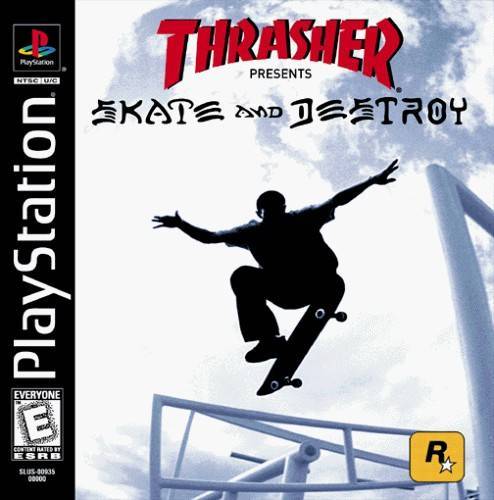
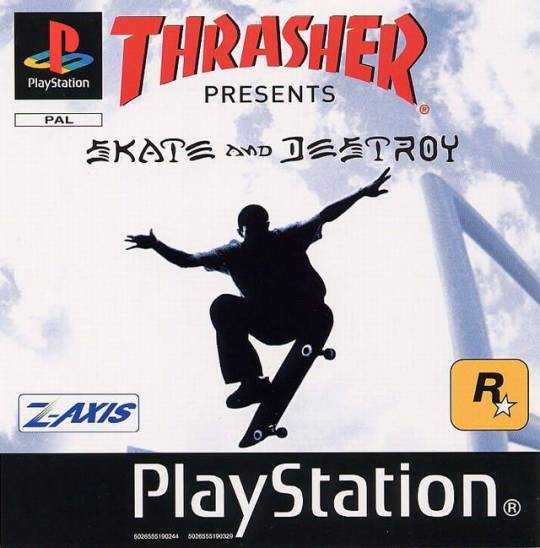
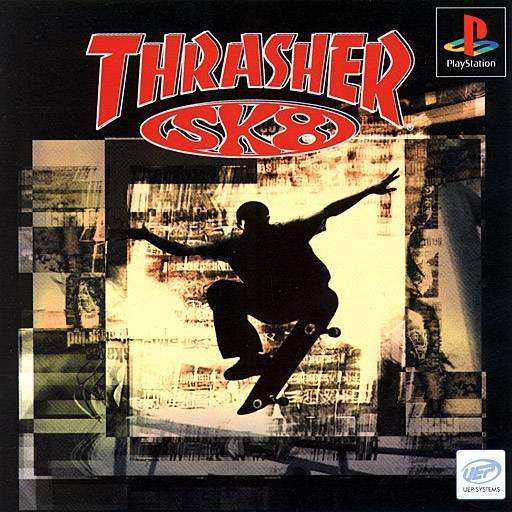

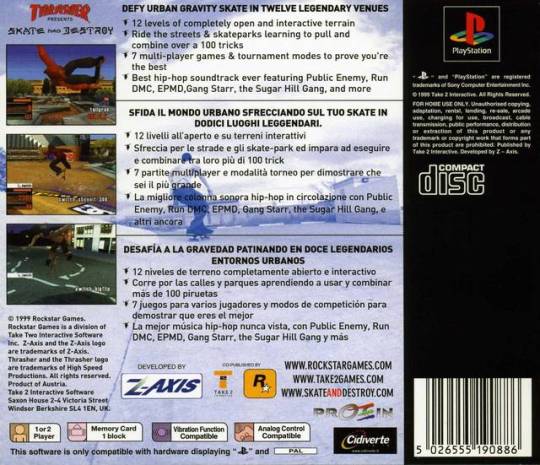

28 notes
·
View notes